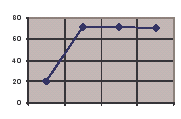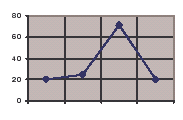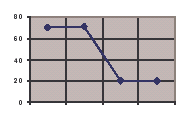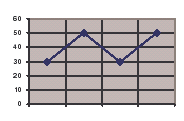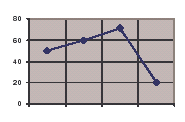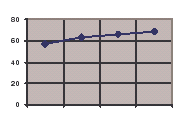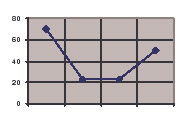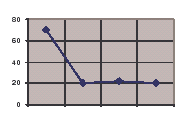ВУЗ: Не указан
Категория: Не указан
Дисциплина: Не указана
Добавлен: 11.11.2024
Просмотров: 32
Скачиваний: 0
Describing Changes
21. Look at the table below and write the letter a-f next to the headings 1-6.
|
C |
1 |
DECLINE |
|
F |
2 |
DEGREE OF CHANGE |
|
A |
3 |
DESCRIBING TRENDS |
|
B |
4 |
GROWTH |
|
E |
5 |
IMPROVEMENT |
|
D |
6 |
STABILITY |
|
A |
||||
|
B |
C |
D |
E |
F |
|
accelerate |
decline |
become |
|
|
|
climb |
decrease |
stable |
develop |
dramatically |
|
enlarge |
diminish |
static |
improve |
gently |
|
expand |
drop |
flatten out |
pick up |
quickly |
|
go up |
dwindle |
level off |
recover |
rapidly |
|
grow (grew, grown) |
fall (fell, fallen) |
level out |
|
sharply |
|
increase |
go down |
remain |
|
steadily |
|
peak |
lower |
steady |
|
suddenly |
|
rise (rose, risen) |
reduce |
stable |
|
gradually |
|
shoot (shot) up |
slump |
static |
|
|
|
|
|
unchanged |
|
|
|
|
|
stabilise |
|
|
22. Look at the graph and complete the sentences below using the words and words combinations from the box above in their appropriate forms.
This graph shows the sales results for the last year.
We had a quiet start of the year. Sales (1)r………………………… s………………………… at 6,000 units in January and February. In March the spring sales campaign started, you can see that the sales (2)c……………………………. to 7,000 then and they (3)w………………………… u………… by another 1,000 units in April to (4)s……………………………. at 8,000 units. Our competitors launched a rival product in May and our sales (5)f……………………………. to 5,000 units. They (6)d……………………… by another thousand units in June. But we (7)i……………………… our discounts to the wholesalers and the sales (8)r……………………………. s……………………………., back to 5,000 units in July and then to 6,000 units in August. The (9)d……………………………. r……………………………. came in the next two months. The sales (10)g……………………………. from 10,000 units in September to 13,000 units in October because of the Christmas orders. And the sales (11)w……………………………. d……………………………. by 6,000 units in November when the Christmas orders stopped. They (12)s……………………………. at 7,000 units until the end of the year.
Answer grid
|
1 |
remained steady/ remained stable |
4 |
stand/ stabilise |
7 |
increased |
10 |
grew |
|
2 |
climbed |
5 |
fell |
8 |
rose steadily |
11 |
went down |
|
3 |
went up |
6 |
decreased/ dropped/ declined |
9 |
dramatic rise |
12 |
stayed/ stabilised |
Prepositions of Change
23. Fill in the missing prepositions in the sentences below. Choose from the following:
|
at |
between |
by |
from |
of |
to |
|
A |
Labour costs have fallen (1)… 22% of total production costs (2)… 14% in the last ten years. That’s 8%! |
1, 2 |
from, to |
|
B |
There was a dramatic fall in sales to the US (3)… 1982 and 1985. |
3 |
between |
|
C |
The company is currently selling 20,000 units (4)… £23 each. |
4 |
at |
|
D |
The growth in sales has led to a rise (5)… 30% in profits. |
5 |
of |
|
E |
A 10% drop in sales has reduced the profit (6)… 40%. |
6 |
by |
|
F |
During 1995/96 we increased retail floor space (7)… 5% (8)… a total (9)… 48,000 m2. |
7, 8, 9 |
by, to, of |
|
G |
They expect to create 1,450 jobs world-wide (10)… the end of next year, at the latest. |
10 |
by |
|
H |
Capital investment for the year stands (11)… £6,000. |
11 |
at |
|
I |
Pre-tax profits reached a peak (12)… $5m two years ago but have been lower since. |
12 |
of |
|
J |
Weekly sales have levelled off (13)… £34,000. |
13 |
at |
|
K |
Increased efficiency has resulted in a lowering of the break-even point from 2,770 (14)… 2,500 units. |
14 |
to |
|
L |
The rise in raw material prices is expected to be (15)… 3.5% and 4.5% this year. |
15 |
between |
25. Match the graphs with their descriptions.
|
c |
1 |
|
a |
Production grew more and more rapidly over the first three quarters but then reached a peak. Since then, it has quickly dropped. |
|
a |
2 |
|
b |
Production fell considerably over the first three quarters, reaching a low of 20. Since then it has staged a partial recovery.
|
|
f |
3 |
|
c |
Production grew rapidly in the first quarter, but reached a plateau of about 70. Since then it has remained more or less stable. |
|
b |
4 |
|
d |
Production has fluctuated all year. |
|
d |
5 |
|
e |
Production showed a marginal rise in the first three quarters, but then suffered a sharp drop.
|
|
e |
6 |
|
f |
Production started the year in a stable position, but then plunged in the third quarter. It has now flattened out at a level of 20. |
|
i |
7 |
|
g |
After a considerable drop in the first two quarters, production bottomed out at 20. Since then it has started to rise. |
|
g |
8 |
|
h |
There was a rapid drop in production in the first quarter, but it bottomed out at about 20. |
|
h |
9 |
|
i |
There has been a slight increase in production over the year. |
Describing graphs
Description 1
In 1987 the export figures stood at 400 million Finnish markkaa. There was a sharp increase between 1987 and 1989 when figures reached over 800 million. This was followed by a sharp decrease between 1989 and 1990 when Finnish paper exports to Japan dropped to 400 million. There was a slight rise between 1990 and 1991 when exports hit the 450 million mark but they fell again to 400 million in 1992. Between 1992 and 1995 there was a dramatic rise and exports of paper to Japan reached a peak of 1,300 million in 1995, before falling again to under 1,000 million in 1997.
Description 2
Graph 1 - Wood
We can see on this graph that wood exports remained stable between 1990 and 1992 at around 50 million Finnish markkaa. Between 1992 and 1994 there was a sharp increase to 500 million where exports levelled off until 1996, then they increased dramatically again and reached a peak of 850 million by 1997.
Graph 2 - Machinery
On this second graph we see that machinery exports declined gradually between 1990 and 1992. Between 1992 and 1995, however, exports of machinery rose continually. In 1993 they were at 400 million and in 1994 they had risen to 550 million. They reached a peak of 700 million in 1995. After that, figures fell slightly to around 650 million in 1996 and levelled off at that number until 1997.
Graph 3 - Chemicals
On this third graph we notice that exports of chemicals remained stable from 1990 to 1992 at 100 million Finnish markkaa. From 1992 to 1993 there was a slight increase to 150 million. After that, exports of chemicals continued to rise steadily from 1993 to 1997. In 1995 they had reached 210 million, and in 1996, they reached a peak of 250 million and stood at this level in 1997.
Describing Sales
(P = Peter, J = John, К = Kate)
|
P: |
I’m glad you managed to make it today. I’d like to start by taking a look at the year’s sales and profit figures. First of all John, could you summarise the sales figures? |
|
J: |
Well, we had a good January –5.2 million. January’s a difficult month because sales always drop after Christmas. In February we launched the new children’s line and it went very well. Total sales "rose to almost 8 million, which was nice. Unfortunately they then plummeted after the fire in the main factory. But by the end of April we had recovered - 10.2 million was the figure - and since then sales have gone up steadily month by month. The December figures aren’t in yet, but it looks like we will probably reach 15 million this month. |
|
P: |
Good. I’ve got a couple of questions, but I’ll save them for later. Kate, sales have increased, but has that meant higher profits? |
|
K: |
Yes, it has. We’re waiting for the final figures, but we already know that overall, in the first three quarters of the year, profits rose by 15% compared to last year, from 960,000 to 1.1 million. In fact since April, profits have increased every single month and they are still going up. |
|
P: |
What about next year? |
|
K: |
Well, as you know, next year we’re going to centralise distribution so costs will decrease. Even if sales level off, profits will improve. |
